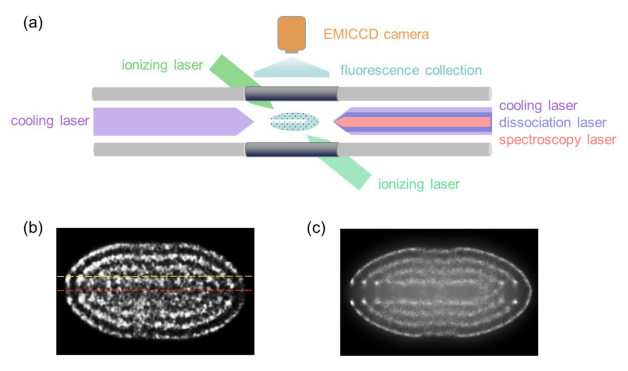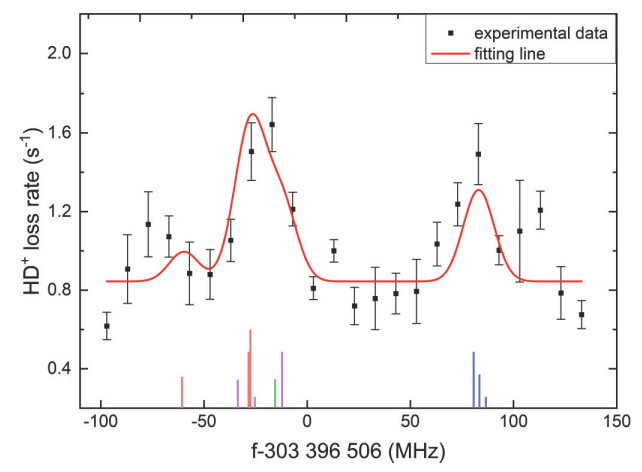Recently, the research team on cold molecular ions from the Innovation Academy for Precision Measurement Science and Technology (APM) has made significant progress in the precise measurement of the vibrational-rotational spectra of hydrogen molecular ions (HD⁺). The research team prepared a Be⁺-HD⁺ two-component ion Coulomb crystal with a temperature on the millikelvin scale in a linear ion trap. They innovatively developed quantum state preparation and spatially resolved fluorescence detection techniques, and successfully measured the high-resolution vibrational-rotational transition spectra of HD⁺ molecular ions.
The HD⁺ ion, as the simplest heteronuclear molecular ion, is composed of one proton, one deuteron, and one electron. The vibrational-rotational transition energy can be precisely calculated, making it an ideal system for testing Quantum Electrodynamics (QED) theory and determining fundamental physical constants (such as the proton-electron mass ratio).
Experimentally, to reduce Doppler broadening, the research team employed laser-cooled beryllium ions for collaborative cooling, lowering the temperature of HD⁺ ions to 18 millikelvins (mK). To address the issue of low population of the HD⁺ molecule in the vibrational-rotational ground state (v = 0, N = 0), the resonance-enhanced threshold photoionization (RETPI) technique was employed to precisely prepare HD⁺ ions in the vibrational-rotational ground state, with an initial quantum state population degree reaching 93%. Compared with traditional cryogenic cooling or optical pumping methods, this technique can significantly increase the ground-state population rate, laying a solid foundation for subsequent high-resolution transition detection.

Synergistically cooled Be⁺-HD⁺ ion crystal and molecular dynamics simulation
Additionally, in the two-component ion crystal, HD⁺ ions appear as non-fluorescent "dark ions", and the change in the number of HD⁺ ions during resonant dissociation is the key to spectral measurement. The research team proposed a spatially resolved fluorescence collection technique, using a high-sensitivity electron-multiplying intensified CCD camera (EMICCD) to perform real-time acquisition of ion crystal images, enabling non-destructive and real-time measurement of the number of HD⁺ ions (Figure 1).

Vibrational-rotational transition spectrum with resolved hyperfine structure of HD⁺
Based on the aforementioned innovative methods, the research team successfully measured, for the first time, the vibrational-rotational transition spectrum of HD⁺ ions (v,N):(0,0)→(6,1) (Figure 2). The transition frequency value is 303,396,506.7(20) MHz, with a relative accuracy reaching 6.6 ppb, which is consistent with the current most precise quantum electrodynamics (QED) theoretical prediction. Combining theoretical calculations, the team further deduced that the value of the proton-electron mass ratio (μpe) is 1836.152648(45), which is consistent with the 2022 recommended value of the International Council for Science: Committee on Data for Science and Technology (CODATA).
The research achievements were published in the journal Physical Review A under the title "Rovibrational spectroscopy of state-selected HD⁺ ions through spatially resolved fluorescence collection". ZHANG Qianyu, a Ph.D. student from APM, is the first author of the article. Assistant researcher HE Shengguo and researcher TONG Xin are the co-corresponding authors.
This research work was supported by the National Key Research and Development Program and the National Natural Science Foundation.
Link to the article: https://doi.org/10.1103/qxyn-jx1t
